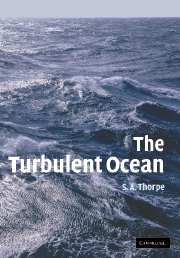Book contents
- Frontmatter
- Contents
- Preface
- Structure and résumé
- Acknowledgements
- 1 Heat, buoyancy, instability and turbulence
- 2 Neutral stability: internal waves
- 3 Instability and transition to turbulence in stratified shear flows
- 4 Convective instabilities
- 5 Instability and breaking of internal waves in mid-water
- 6 The measurement of turbulence and mixing
- 7 Fine-structure, transient-structures, and turbulence in the pycnocline
- 8 The benthic boundary layer
- 9 The upper ocean boundary layer
- 10 Shallow seas
- 11 Boundary layers on beaches and submarine slopes
- 12 Topographically related turbulence
- 13 Large-scale waves, eddies and dispersion
- 14 Epilogue
- Appendices
- References
- Index of laboratory experiments
- Subject index
- Plate section
7 - Fine-structure, transient-structures, and turbulence in the pycnocline
Published online by Cambridge University Press: 05 June 2012
- Frontmatter
- Contents
- Preface
- Structure and résumé
- Acknowledgements
- 1 Heat, buoyancy, instability and turbulence
- 2 Neutral stability: internal waves
- 3 Instability and transition to turbulence in stratified shear flows
- 4 Convective instabilities
- 5 Instability and breaking of internal waves in mid-water
- 6 The measurement of turbulence and mixing
- 7 Fine-structure, transient-structures, and turbulence in the pycnocline
- 8 The benthic boundary layer
- 9 The upper ocean boundary layer
- 10 Shallow seas
- 11 Boundary layers on beaches and submarine slopes
- 12 Topographically related turbulence
- 13 Large-scale waves, eddies and dispersion
- 14 Epilogue
- Appendices
- References
- Index of laboratory experiments
- Subject index
- Plate section
Summary
Introduction
Preceding chapters have described the mechanisms or processes that lead to turbulence in the ocean, and the means that are available for its measurement. Described in this chapter are observations of the processes, and of the consequent turbulence and mixing within the body of the ocean, here referred to as the pycnocline or as ‘mid-water’ to distinguish it from the parts of the ocean that are in close contact and affected by the immediate presence of boundaries. Later chapters are devoted to describing turbulence within the boundary layers themselves, those at the seabed or the air–sea interface.
The temperature in large natural bodies of water rarely decreases smoothly in depth through the thermocline and underlying water mass; usually it changes irregularly. Interest in measuring temperature in the upper ocean developed rapidly during and after World War I because of the recognition of the value of sonar (SOund Navigation And Ranging) in detecting vessels or icebergs, in the measurement of water depth, and in submarine navigation and detection. The speed of sound in seawater, typically about 1500 m s−1, varies with temperature. For example, near the surface it increases by 3.6 m s−1 per 1 K increase at 10 ℃ and 35 psu. Sound is consequently refracted in the thermocline, limiting its use in detection unless the thermal structure is known.
The bathythermograph (BT) was introduced in the mid-1930s to measure temperature profiles.
- Type
- Chapter
- Information
- The Turbulent Ocean , pp. 190 - 212Publisher: Cambridge University PressPrint publication year: 2005



